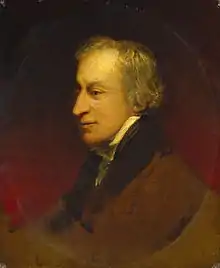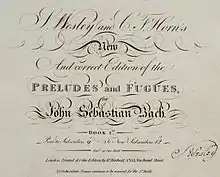Samuel Wesley
Samuel Wesley (24 February 1766 – 11 October 1837) was an English organist and composer in the late Georgian period. Wesley was a contemporary of Mozart (1756–1791) and was called by some "the English Mozart".[1]
Samuel Wesley | |
|---|---|
 | |
| Born | 24 February 1766 Bristol South West England |
| Died | 11 October 1837 |
| Occupation | organist and composer |
| Children | 7 (including Samuel Sebastian Wesley) |
| Parent(s) | Charles Wesley and Sarah Wesley |
Personal life
Born in Bristol, he was the son of noted Methodist and hymnodist Charles Wesley, the grandson of Samuel Wesley (a poet of the late Stuart period) and the nephew of John Wesley, the founder of the Methodist Church.
His early musical education mostly took place in the family home in Bristol, where Sarah Wesley, his mother, sang and played the harpsichord. Hymn tunes and the works of Handel were the family's favourite pieces. Samuel also had lessons from David Williams, the organist of All Saints' Church, Bristol. In 1771 his father acquired a second house, in Chesterfield Street, Marylebone, London. Samuel left Bristol for the house in London by 1778.[2]
Samuel informed his mother of his philosophical conviction that his marriage had been constituted by sexual intercourse, precluding any civil or religious ceremony, but after a scandalous delay he married Charlotte Louise Martin in 1793, and they had three children. This marriage broke up with Charlotte's discovery of Samuel's affair with the teenaged domestic servant Sarah Suter.[1] Samuel and Sarah never married but had four children together, among them Samuel Sebastian Wesley (1810–1876) who was a cathedral organist and notable composer.
.jpg.webp)
In 1784, Wesley privately converted to Roman Catholicism, to the dismay of his uncle John Wesley.[3] His hymnodist father expressed his opinion in the following words:
While ready and resolved is he to plunge into the dark abyss
And cast his soul away
That poison of the Romish sect
O let not his soul infect[4]
To celebrate his conversion, Samuel composed an elaborate Mass, the Missa de Spiritu Sancto, dedicating it to Pope Pius VI.[3] According to his obituary, he may subsequently have denied any conversion.[5]
Career
Samuel showed his musical talent early in life. As a boy, he was recognised as a child prodigy by the British musical establishment, along with his elder brother, Charles. He quickly mastered the violin, harpsichord and organ. By the age of eight, he was becoming known for his composing and improvisational skills. His father, Charles, wrote:
He was full eight years old when Dr [William] Boyce came to see us and accosted me with, 'Sir, I hear you have an English Mozart in your house'. I called Sam to answer for himself. He had by this time scrawled down his Oratorio of Ruth. The Doctor looked it over very carefully and seemed highly pleased with the performance. Some of his words were, 'These airs are some of the prettiest I have seen. This boy writes by nature as true a bass as I can do by rule and study'.[6]
Wesley worked as a conductor as well as a music teacher and lecturer. He seems to have been one of the pioneers of the British organ recital: prior to his time, entertainment was not considered appropriate for a church building. Despite a reputation as the best improvisor on the organ in England, he never succeeded in obtaining an organist's post though he applied to the Foundling Hospital both in 1798 and 1813 and to St George's, Hanover Square in 1824. Generally he appeared to be mistrusted by the British establishment, perhaps due to a forthright manner, his marriage arrangements and it is possible to speculate that he was unreliable. From 1815 onwards, he was beset by lack of money and depression. At one stage, he was reduced to asking Vincent Novello for copying work.
His ability on the organ was so highly regarded that he was introduced to, and played for Felix Mendelssohn in September 1837, a month before Wesley's death. Mendelssohn gave a recital at Christ Church Newgate, during which Wesley said to his daughter Eliza, "This is transcendent playing! Do you think I dare venture after this?" It seems that Mendelssohn persuaded the old man, who was by now very frail, to play. Mendelssohn stood by his side while he was playing and complimented him, but Wesley replied "Ah, Sir! you have not heard me play; you should have heard me forty years ago".[7]

Wesley seems to have become acquainted with the works of Johann Sebastian Bach sometime between 1796 and 1808. Prior to that, the German-born Charles Frederick Horn had been appointed in 1789 as musician to the royal household at Windsor. Their joint publication and popularisation of Bach's work have been described as an "English Bach awakening".[8] No time was lost in converting others to the Bach cause; Wesley's principal converts were William Crotch and Charles Burney. In a series of letters to his friend, Benjamin Jacob, Wesley documented how he made Bach better appreciated.
Francis Routh[9] has compiled a list of all Wesley's keyboard works and hymn tunes, although some further organ pieces have subsequently been discovered. A complete list of Wesley's musical output would include:
- over 120 organ pieces
- 41 Latin motets and the cantata Confiteor tibi Domine
- at least two Masses, the Missa Solemnis and the previously mentioned Missa de Spiritu Sancto, his largest work, scored for solo voices and chorus, with strings, oboes, horns, trumpets and drums.
- 6 symphonies and 4 orchestral overture-type works
- 5 organ concertos; 4 violin concertos; 2 harpsichord concertos; 2 string quartets; the Sinfonia Obligatto in D for organ, violin and 'cello; a quintet for strings, organ and two horns.
- at least 65 piano pieces and over 100 hymn tunes.
- anthems described by Wesley himself in a letter "too numerous to particularize".
- a number of arrangements of work by other composers, including adapting many of Bach's organ works to be played on the less flexible English organ of the day. Many of these were transcribed as organ duets.
Many of his best-known compositions were written for the church; they include the motet In exitu Israel. His secular compositions include the five-part madrigal 'O singe unto mie roundelaie', entered for the Prize Cup, offered by the Madrigal Society in 1813 and set to the well-known poem by Thomas Chatterton.
However, much of his work was published at the time of composition and then forgotten, and so copies of these works are rare and mostly unavailable in modern performing editions. A considerable body of work exists in manuscript only.
Wesley's compositional style was eclectic, with influences from the late Baroque era, Classicism and, later, early Romanticism.
In 1788 Wesley was initiated into Freemasonry in the Lodge of Antiquity, London. The Duke of Sussex appointed him Grand Organist of the Premier Grand Lodge of England in 1812, and he continued in office through the process of Masonic unification in 1813, serving as the first Grand Organist of the United Grand Lodge of England. He served as Grand Organist for five years, standing down in 1818.[10]
Samuel died in 1837 aged 71, and was buried in St Marylebone Parish Church, London.
References
- Kassler, Michael & Olleson, Philip (2001). Samuel Wesley (1766–1837): A Source Book. Ashgate.
- Barry, Joseph (2010). Temperley, Nicholas; Banfield, Stephen (eds.). Music and the Wesleys. Urbana: University of Illinois Press. pp. 141–146. ISBN 978-0-252-07767-8.
- Olleson, Philip (2003). Samuel Wesley : the man and his music (1. publ. ed.). Woodbridge, Suffolk, UK: Boydell Press. p. 29. ISBN 1843830310.
- Cited by Carroll WP (1989) PhD Thesis: The Latin Choral Music of Samuel Wesley, University of Cincinnati, USA
- "Obituary". The Times. 12 October 1837.
- Routley, E. (1968). The Musical Wesleys. London: Herbert Jenkins.
- Hinrichsen, M (1962). 'Wesley and Mendelssohn in England' in 'Samuel Wesley and Dr. Mendelssohn, Three Organ Fugues'. London: Hinrichsen. pp. 2–8.
- Kassler 2004
- Routh, Francis (1973). Early English Organ Music from the Middle Ages to 1837. London: Barrie & Jenkins.
- "Famous Freemasons". United Grand Lodge of England. Retrieved 10 May 2019.
- Philip Olleson, ed. (2001), "Biographical introduction" (PDF), The Letters of Samuel Wesley: Professional and Social Correspondence, 1797–1837, Oxford University Press, ISBN 9780198164234
- Michael Kassler, "Samuel Wesley's 'madness' of 1817–18", History of Psychiatry, v. part 4 (2003), pp. 459–74.
- Kassler, Michael (2004), The English Bach awakening: knowledge of J.S. Bach and his music in England, 1750–1830, Ashgate, ISBN 1-84014-666-4
- J T Lightwood, "Samuel Wesley, Musician", London, Epworth (1937)
External links
- Free scores by Samuel Wesley in the Choral Public Domain Library (ChoralWiki)
- Works by Samuel Wesley (1766–1837)
- Family tree of Methodist founder John Wesley (link starts with Samuel Wesley)
- Free scores by Samuel Wesley at the International Music Score Library Project (IMSLP)
- BBC Composer of the Week: Samuel Wesley, 3–7 February, 2020